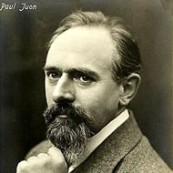Composers
Paul Juon (Pavel Fyodorovich Yuon, March 6, 1872 – August 21, 1940) was a Germanised Russian composer.
He was born in Moscow, where his father was an insurance official. His mother was German, and he went to a German school in Moscow. He entered the Moscow Conservatory in 1889, where he studied violin with Jan Hřímalý and composition with Anton Arensky and Sergei Taneyev. He completed his studies at the Hochschule für Musik in Berlin, under Woldemar Bargiel. His first (privately) printed works, two Romanzen (lieder) appeared in 1894, the year he began studies with Bargiel. During his time in Berlin he was a composition professor, employed by Joseph Joachim; his students included Heinrich Kaminski, Stefan Wolpe, Philipp Jarnach, Max Trapp, Henry Jolles, and Gunnar Johansen. He moved to and retired in Switzerland in 1934, and died in Vevey.
His works include sonatas for viola, cello, winds, and three for violin (the third was recorded on a multi-LP set called Musik zwischen den Kriegen : eine Berliner Dokumentation), four symphonies (including one in manuscript) and also a chamber symphony, four string quartets, several piano trios, piano quartets and piano quintets as well as one sextet for piano and strings from 1902 and a wind quintet, a number of concerted works including three violin concerti and a triple concerto with piano trio, many piano works and lieder, and a number of stage works including an opera Aleko.
Several of these works have been recorded on compact disc, including several of the sonatas, two of the concertos, all four string quartets and all of the piano trios.
He also translated Tchaikovsky's Guide to the Practical Study of Harmony into German.
He was twice married. His younger brother Konstantin Yuon was a notable painter.
Refine by search
view all| Country: | Germany, Russia |
| Period: | Romantique |
Biography
Paul Juon (Pavel Fyodorovich Yuon, March 6, 1872 – August 21, 1940) was a Germanised Russian composer.
He was born in Moscow, where his father was an insurance official. His mother was German, and he went to a German school in Moscow. He entered the Moscow Conservatory in 1889, where he studied violin with Jan Hřímalý and composition with Anton Arensky and Sergei Taneyev. He completed his studies at the Hochschule für Musik in Berlin, under Woldemar Bargiel. His first (privately) printed works, two Romanzen (lieder) appeared in 1894, the year he began studies with Bargiel. During his time in Berlin he was a composition professor, employed by Joseph Joachim; his students included Heinrich Kaminski, Stefan Wolpe, Philipp Jarnach, Max Trapp, Henry Jolles, and Gunnar Johansen. He moved to and retired in Switzerland in 1934, and died in Vevey.
His works include sonatas for viola, cello, winds, and three for violin (the third was recorded on a multi-LP set called Musik zwischen den Kriegen : eine Berliner Dokumentation), four symphonies (including one in manuscript) and also a chamber symphony, four string quartets, several piano trios, piano quartets and piano quintets as well as one sextet for piano and strings from 1902 and a wind quintet, a number of concerted works including three violin concerti and a triple concerto with piano trio, many piano works and lieder, and a number of stage works including an opera Aleko.
Several of these works have been recorded on compact disc, including several of the sonatas, two of the concertos, all four string quartets and all of the piano trios.
He also translated Tchaikovsky's Guide to the Practical Study of Harmony into German.
He was twice married. His younger brother Konstantin Yuon was a notable painter.



![The Heifetz Collection, Volume 1 [3 CD ]](http://static.classicalm.com/repository/disk-cover/small/715-img1315088819334029.jpg)